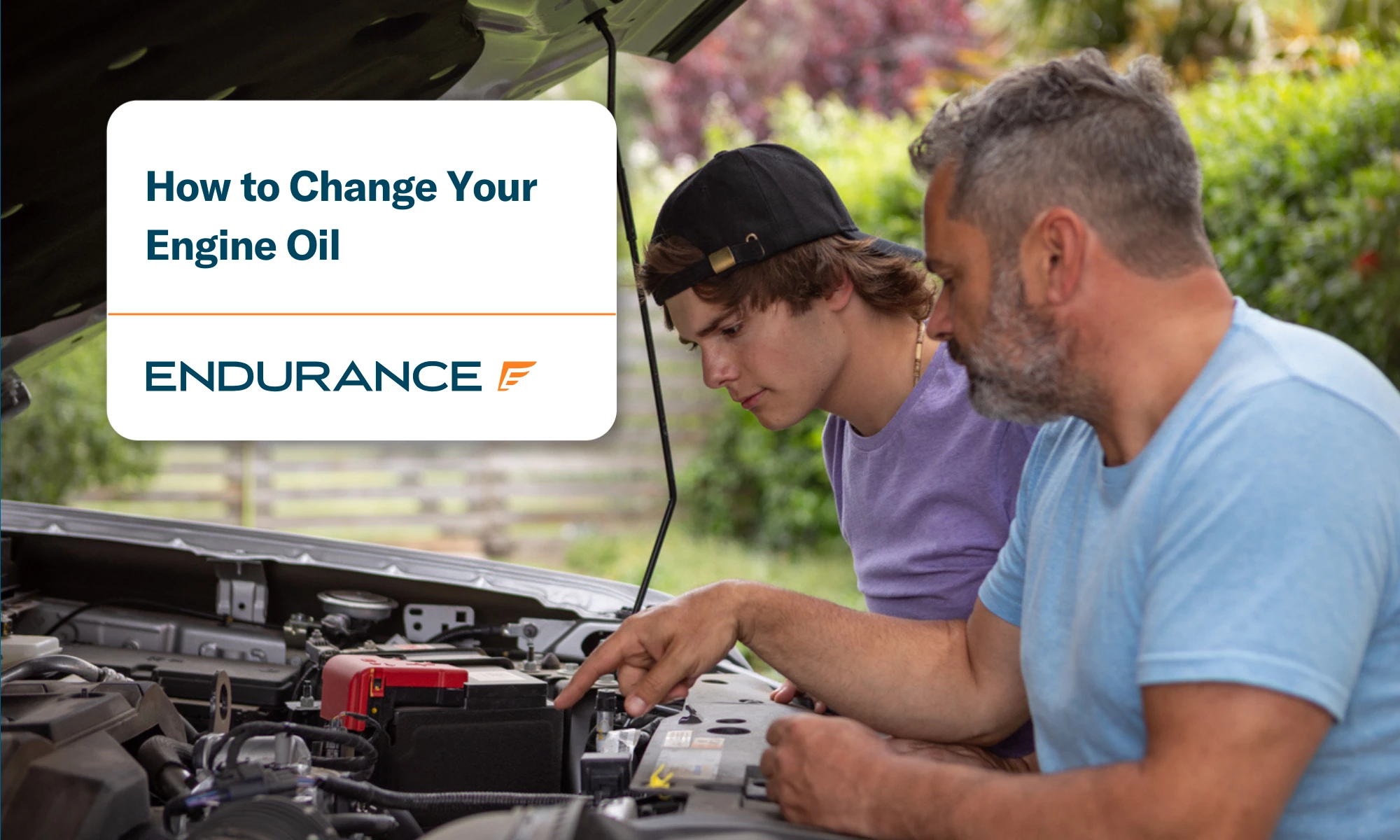Get this deal! Call now.
Speak with a vehicle protection plan specialist and get $300 off any new contract instantly.
Call 866-678-4172
or scan the code below


None of the maintenance requirements for modern internal combustion automobiles are more essential than an oil change. This task ensures a car’s engine runs smoothly with minimal internal wear. Many owners rely on a local garage or a dealership service department for this work. However, taking a DIY approach to change your oil can save money and provide satisfaction to more hands-on-oriented drivers or those looking to understand vehicle upkeep better.
Keep reading for a deep dive into how to change your oil and oil filters. We’ll explore the complete process, from choosing the correct materials to underscoring the importance of maintaining detailed service records for warranty coverage.
There’s more to selecting the correct engine oil and filter than grabbing whatever’s on sale online or at the local auto supply store. While there are several places to skimp when it comes to car care, oil changes aren’t one of them. Spending a few extra dollars helps preserve engine life and extend service intervals.
Today’s engines are highly sophisticated machines that require special materials to maintain optimal performance and prevent damage. Further, oil that’s ideal for one vehicle can be harmful in another. The car’s owner’s manual is the best source for determining your vehicle’s perfect oil and filter. The information will cover critical specifications, such as:
Most automakers recommend specific oil and filter brands. There’s nothing wrong with following this advice, but you can use supplies from other companies if the alternatives meet or exceed the manufacturer’s guidelines.
Viscosity may sound like an elaborate term, but it describes oil thickness. The higher the number, the thicker the oil. The first number — 5W, for example — refers to below-zero-temperature thickness. Meanwhile, the second number — 30, for instance — covers thickness during normal operating temperatures.
Modern engines generally require thinner oils. So, don’t be surprised if your car needs oil with 0W20 or 5W30 specifications. Keep in mind that synthetic motor oil maintains its viscosity longer than conventional or synthetic blend options.
In addition to choosing an oil with the correct specifications, you’ll want to consider other factors:
Picking the right oil filter is the other half of the equation. Here’s what to look for:
Sticking with the manufacturer-recommended filter keeps things straightforward. However, selecting a different product means paying attention to:
These elements may be overwhelming to a novice DIYer. So, always double-check compatibility and only buy from a reputable source.
Performing a car oil change is more than selecting the proper materials; a successful job can only be accomplished with the right tools. The upfront cost of this equipment can eliminate any cost savings, but this will be less of an issue over time and after multiple oil changes. Alternatively, some automotive supply stores offer loaner tools.
Here’s a toolkit checklist:
Safety is a critical element of any car repair, regardless of how simple the task is. This entails having the right resources on hand and properly preparing the vehicle for an oil change. Ideally, a friend can help or at least be on hand for moral support.
For elevating the car via jack/jack stands:
For elevating the car (front end) via ramps:
Continue with the remaining steps:
Pro Tip: While the oil change process is generally the same among different cars, each automobile can have its own quirks. Before tackling any work, review a vehicle-specific service manual for precise instructions. YouTube how-to videos can also be helpful.
 With the preliminary work done, it’s time for the actual oil change.
With the preliminary work done, it’s time for the actual oil change.
Pre-drainage inspection involves:
Empty the oil with these draining process steps:
This critical step ensures clean oil and proper filtration for the engine.
Discarding used engine oil in the trash is a significant no-no. This liquid is considered hazardous and should be treated accordingly. Proper disposal procedures protect the environment and maintain compliance with local regulations.
Start by ensuring the old oil is properly collected:
Next, identify an approved site to drop off the used oil. You can call ahead to confirm the drop-off procedure and other requirements. Locations often include:
Depending on the facility and regulations, you may be required to provide documentation that includes your name, contact information, oil type, and other pertinent information.
Keeping detailed records of your oil changes isn’t just good practice; it’s essential for maintaining your vehicle’s warranty coverage. Most extended warranty providers require proof of regular car maintenance before honoring claims, making documentation your first line of defense against denied claims.
For DIY oil changes, keep a detailed log containing:
While doing your own oil changes can save money, consider having maintenance work done at a licensed shop. Professional service centers provide verifiable records that warranty companies prefer.
In addition, many vehicle service contracts require maintenance records showing regular oil changes with approved materials. Missing or incomplete records can void your coverage, even for issues unrelated to oil changes. This makes it crucial to document every service, whether performed at home or by professionals.
Most importantly, keep these records organized and easily accessible. Store digital copies of all maintenance documentation in a dedicated electronic folder and maintain physical copies in your vehicle’s service folder. You’ll be readily able to supply any necessary records.
One inescapable fact of car ownership is that, eventually, every automobile needs servicing. Older vehicles are especially vulnerable to breakdowns and surprise repair bills. Savvy drivers have learned that an extended warranty (also called a vehicle service contract or auto protection plan) can protect cars no longer covered by factory warranties.
Endurance offers a range of vehicle protection plans designed to minimize the financial impact of mechanical issues. A powertrain plan covers the engine, transmission, and drive axle, which are often the most expensive components to work on. The most comprehensive program delivers new car-like coverage similar to a bumper-to-bumper warranty.
Meanwhile, the Advantage plan provides expanded protection and up to $3,500 for routine maintenance, including oil changes, diagnostic exams, and tire rotations. It also allows for one-time services such as battery replacement and cooling system maintenance.
All Endurance programs include 24/7 roadside assistance (with towing and other services), rental car support, trip interruption protection, flexible payment terms, and the freedom to choose any licensed repair facility for covered repairs. Every customer is eligible for a year of Elite Benefits for access to tire repairs and replacements, key fob replacement, collision repair discounts, and total loss protection.* Just pay a small enrollment fee to activate these valuable services when starting Endurance coverage.
Hit the road backed by Endurance protection. Request a free online quote or explore the Endurance online store for instant pricing and plan details. For more personalized service, call an Endurance plan advisor at (800) 253-8203.
Read the Endurance blog for helpful articles about vehicle maintenance, DIY advice, warranty insights, car reviews, and more.

We're here to make sure you get the most comprehensive EV protection. That's why we've partnered with Xcelerate Auto to offer you transparent and dependable Tesla coverage.
Want us to contact you about XCare coverage for your Tesla?



Call for $300 off any new plan!
By clicking the button, you consent to Endurance using automated technology to call, email, and text you using the contact info above, including your wireless number, if provided, regarding auto protection or, in California, mechanical breakdown insurance. You also agree to the Endurance Privacy Policy and Terms and Conditions. Consent is not a condition of purchase, and you can withdraw consent at any time. Message and data rates may apply.
Speak with a vehicle protection plan specialist and get $300 off any new contract instantly.
Call 866-678-4172
or scan the code below



Simply fill out the information below and we will follow up fast with your free no-obligation quote.
By clicking the button, you consent to Endurance using automated technology to call, email, and text you using the contact info above, including your wireless number, if provided, regarding auto protection or, in California, mechanical breakdown insurance. You also agree to the Endurance Privacy Policy and Terms and Conditions. Consent is not a condition of purchase, and you can withdraw consent at any time. Message and data rates may apply.

To speak to a vehicle protection plan specialist and save $300
Scan the code below
Larry Witherspoon Jr. is a co-founder and Executive Director of the Automotive Training Center. Larry has held multiple leadership positions in the U. S. Navy and with various Fortune 100 companies. In addition to his business experience, Larry grew up understanding the difficulties all young men face becoming adults especially those that come from challenging circumstances. He has taken those experiences growing up and combined them with his passion for vehicles to start the Automotive Training Center. Read more about Larry.